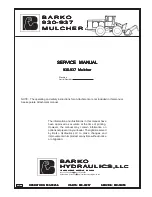
8
TROUBLESHOOTING
PROBLEM
CAUSE
1. Low battery capacity:
a. Observe
the
electrolyte
level in the cell windows and
make certain level is between the two scribed lines on
the cell windows.
b. Continuous use of battery that has not been fully
charged will cause it to lose its capacity. This may be
corrected by cycling the battery several times
(discharge 8 hours and recharge 16 hours). Repeat
this procedure 3 times. If battery does not respond,
replace with a new one.
c. Battery not charged.
2. Loose
connections:
a. Gently wiggle or pry each connection on top of the
battery to make sure it is tight and working properly.
b. Check the cables for broken conductors by twisting or
pulling it at various points along its length.
c. Check the headpiece terminals and the electrical
connections inside the headpiece in the same manner
as those on the battery.
d. Make sure the bulb is secure and making good
contact.
e. If the light flickers or dims when any of the preceding
items are being checked, that item should be repaired
or replaced.
Bulb glows dimly, flickers or fails
3. Electrolyte
level:
a. Check at least once each month to see that the
electrolyte level is between the two scribed lines on
the cell window.
Battery not holding a charge during shift
a. Make sure charger output is correct.
b. Check electrolyte level after charge
c. Make sure connections between headpiece and
battery are good.
d. Make sure that charging rack connections are good.
e. Make sure stored batteries are boost charged before
placing into service.
Battery capacity
a. 13Ah battery recommended for 8-10 hour discharge /
16-14 hour charge, 5 days a week. Use the 16Ah
battery for greater cycle routines.
b. Check
charger.
c. Check battery connections.
IMPORTANT : ALWAYS RECHARGE THE LAMP AFTER USE.
Содержание OLDHAM GS
Страница 11: ...11 ...





























